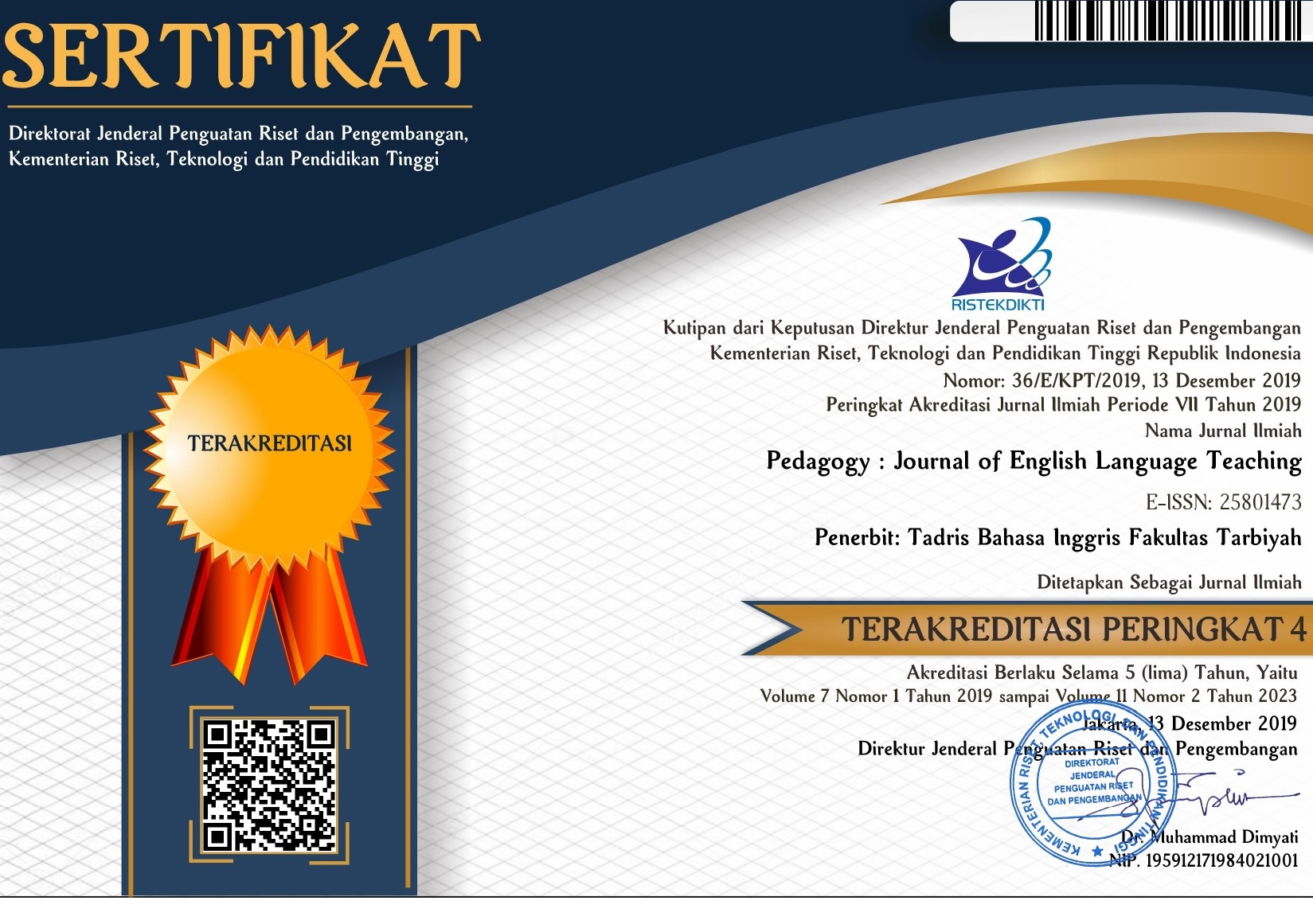An Analysis Of Inflectional Affixes Error In Argumentative Writing
DOI:
https://doi.org/10.32332/pedagogy.v6i1.1116Keywords:
Inflectional affixes, grammar, WritingAbstract
The aim of the research is to find the error of using inflectional affixes in students’ argumentative writing of the fifth semester of English Department of IAIN Metro. This research is descriptive-qualitative research. This descriptive-qualitative research use two sources, primary and secondary data, the primary data is achieved through the argumentative writing text from the fifth students semester of IAIN Metro. Then the secondary data is collected from archival. This research applies Creswell model to analyze the data. The findings research shows there are 9 argumentative writing result, they have eight errors in using {–s}, 2 errors in using {–es}, 1 error in using {–ies}, 13 errors in using {–ed}, 3 errors in using {–ing}, and there is no error in using {–er} and{–est}. Based on the data, the first error that commonly found in students’ writing production is the use of {–ed}, and the second one is the use of {–s}, and the third one is the use of {–es}. Most of the fifth semester students of the English Department of IAIN Metro have lack of knowledge about inflectional affixes and there are many students who feel difficult in deciding which one is the correct affix for the word they want. It means there are many students of the fifth semester of English Department of IAIN Metro that still can not use the inflectional affixes correctly. The conclusion of the research is the student of the fifth semester of English Department of IAIN Metro need attention to focus on writing argumentative learning and semantic specially ‘inflection affixes’.
References
Bayram, F. (2010). Ideology and Political Discourse: A Critical Discourse Analysis of Erdogan’s Political Speech. ARECLS, 7(1), 18.
Deocampo, M. F. (2015). The New English Teacher. The New English Teacher, 9(1), 38–62.
Eriyanto. (2009). Analisis Wacana: Pengantar Analisis Teks Media. Yogyakarta: Lkis.
Esfehani, L. S. (2013). From Macro and Microstructures to an Innovation: The Macrofiction Structure. International Journal of English Language and Linguistics Research, 1(2), 18.
Fairclough, N., Mulderrig, J., & Wodak, R. (1997). Critical Discourse Analysis. In Discourse Studies: A Multidisciplinary Introduction (p. 357). London: Sage Publication.
Gowhary, H., Rahimi, F., Azizifar, A., & Jamalinesari, A. (2015). A Critical Discourse Analysis of the Electoral Talks of Iranian Presidential Candidates in 2013. Procedia - Social and Behavioral Sciences, 192, 132–141. https://doi.org/10.1016/j.sbspro.2015.06.020
Kone, A. M. (2016). Metaphor in Ir. Soekarno’sSpeech. Researchers World : Journal of Arts, Science and Commerce, 7(4), 153–157. https://doi.org/10.18843/rwjasc/v7i4(1)/18
Madkur, A. (2013). Grammatical Analysis on the Abstract of Scientific Writing. Pedagogy: Journal of English Language Teaching, 1(1), 52–67.
Madkur, A. (2014). Pragmatics in EFL Instruction: Speech Acts in English Speaking Class (Vol. 1, p. 7). Presented at the Siliwangi International English Conference (SIEC), Tasikmalaya: Siliwangi University.
Priatmoko, F. X. N. A., & Cahyono, S. P. (2013). Critical Discourse Analysis of Susilo Bambang Yudhoyono’s Speech. Dian Nuswantoro University Semarang, 14.
Rachman, A., & Yunianti, S. (2017). Critical Discourse Analysis in Donald Trump Presidential Campaign to Win American’s Heart. TELL Journal, 5(2), 8–17.
Saadabad, M. H., & Kasmani, M. B. (2014). A Critical Discourse Analysis of Summit Series: There presentation of Social Actors. Asian Journal of Social Sciences & Humanities, 3(2), 61–71.
Saputro, E. P. N. (2015). The Analysis of Illocutionary Acts of Jokowi’s Speeches (Master Thesis). Sanata Dharma University, Yogyakarta.
Van Dick, T. A. (1995). Discourse Analysis as Ideology Analysis. In Language and Peace (pp. 17–33). Aldershot: Darmouth Publishing.
Van Dick, T. A. (2001). Multidisciplinary CDA: A Plea for Diversity. In Methods of Criticaal Discourse Analysis. London: Sage Publication. Retrieved from http://www.discourse.org
Wang, J. (2010). A Critical Discourse Analysis of Barack Obama’s Speeches. Journal of Language Teaching and Research, 1(3), 254–261. https://doi.org/10.4304/jltr.1.3.254-261
Wang, Y., & Guo, M. (2014). A Short Analysis of Discourse Coherence. Journal of Language Teaching and Research, 5(2), 460–465. https://doi.org/10.4304/jltr.5.2.460-465















